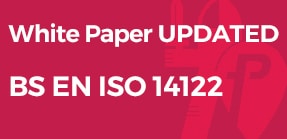Procter Machine Safety has published a new version of its free White Paper explaining BS EN ISO 14122, Safety of machinery – permanent means of access. This revised and updated edition is available as a free download and will be useful for designers, engineers and managers working in a broad spectrum of manufacturing and process industries.

Procter Machine Safety has published a second edition of its free White Paper explaining BS EN ISO 14122, the standard for permanent means of access to machinery.
BS EN ISO 14122 is a four-part standard, with part 5 currently in preparation. Part 1 covers the choice of fixed means of access and the general requirements, part 2 relates to working platforms and walkways, part 3 is for stairs, stepladders and guard-rails, and part 4 addresses fixed ladders. All four parts are Harmonised to the European Machinery Directive 2006/42/EC for the purposes of CE marking and, since the UK left the EU, they are also designated standards for UKCA marking machinery placed on the market in Great Britain. An introduction to UKCA marking is one of the additions in the new edition of Procter’s White Paper.
While compliance with BS EN ISO 14122 is not mandatory, it is highly recommended that reference is made to the relevant parts of the standard, whether custom-designed or modular access systems are being used. As the White Paper explains, BS EN ISO 14122 part 1 must always be applied in conjunction with part 2, 3 or 4. Likewise, part 2, 3 or 4 must always be applied alongside part 1.
Rather than provide a clause-by-clause analysis of the standard, the White Paper explains some of the concepts and technical details that are not immediately obvious. It therefore helps people understand and interpret the standard, whether they are new to designing permanent means of access or have designed them before using a previous edition of the standard. Procter Machine Safety believes that its updated White Paper is the most comprehensive guide to the 2016 edition of BS EN ISO 14122.
DOWNLOAD THE UPDATED BS EN ISO 14122 WHITE PAPER
Edition 2 of the White Paper adds information about UKCA marking, and there are also revisions to the lists of resources and sources of further information. These cover topics such as risk assessments, safety distances and machine guarding standards, as well as official guidance from the HSE (Health and Safety Executive), European Commission and BEIS (the UK Government Department for Business, Energy & Industrial Strategy).
Anyone responsible for specifying or designing machines or permanent means of access, including buildings or civil constructions where the main function is to provide access to a machine or process, should read the updated White Paper. Furthermore, although the standard is not applicable retrospectively, the White Paper will be helpful to readers who are concerned about the adequacy and safety of existing permanent means of access.
Thomas Shapland, Marketing Director of Procter Brothers, comments: “This revised White Paper is written by Steve Allen CMSE, one of the most respected machine guarding specialists in the UK. Permanent means of access are far safer than freestanding ladders or other ad hoc means of access, as well as having a lower total cost of ownership than tower scaffolds or scaffolding structures that have to be erected repeatedly. However, it is important that the standard is complied with when providing permanent means of access, otherwise there is a risk of new hazards being introduced. If, having read the White Paper, companies want to improve their access, we can undertake a site survey and then design, manufacture and install high-quality, cost-effective, standards-compliant permanent means of access.”
To download a PDF copy of the updated White Paper ‘The requirements for machinery guarding with respect to PUWER’, go to https://www.machinesafety.co.uk/free-downloads. Alternatively, contact Procter Machine Safety to discuss specific projects by emailing info@machinesafety.co.uk or telephone 02920 855758.
